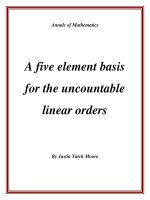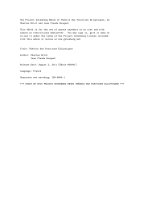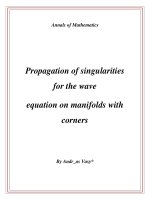Convolution for The Offset Linear Canonical Transform with Gaussian Weight and Its Application
Bạn đang xem bản rút gọn của tài liệu. Xem và tải ngay bản đầy đủ của tài liệu tại đây (722.9 KB, 8 trang )
<span class='text_page_counter'>(1)</span><div class='page_container' data-page=1>
47
Original article
Convolution for The Offset Linear Canonical Transform
with Gaussian Weight and Its Application
Quan Thai Ha
1,*<sub>, Lai Tien Minh</sub>
2<sub>, Nguyen Minh Tuan</sub>
3<i>1</i>
<i>Faculty of Mathematics, Mechanics and Informatics, VNU Hanoi University of Science, </i>
<i>334 Nguyen Trai, Hanoi, Vietnam </i>
<i>2<sub>Department of Mathematics, Hanoi Architectural University, Hanoi, Vietnam </sub></i>
<i>3<sub>Department of Mathematics, VNU University of Education, 144 Xuan Thuy, Hanoi, Vietnam </sub></i>
Received 26 November 2018
<i>Revised 25 February 2019; Accepted 15 March 2019 </i>
<b>Abstract: This paper presents the convolution for the offset linear canonical transform (OLCT) </b>
with the Gaussian weight and its applications. The product theorem is also studied. In applications,
some ways to design the filters in the OLCT domain as well as the multiplicative filter and the
Gaussian filter are introduced.
<i>Keywords and phrase: Reconstruction, Shannon theorem, convolution, filter, signal, offset linear </i>
canonical transform, fractional Fourier transform, Fourier transform.
<b>1. Introduction</b>
Throughout this paper we shall consider parameters <i>a b c d u</i>, , , , 0,0 and <i>i will be denoted the </i>
unit imaginary number. The Offset Linear Canonical Transform (OLCT) (see [1]) of a signal <i>f t </i>
with real parameters <i>A</i>
<i>a b c d u</i>, , , , <sub>0</sub>,<sub>0</sub>
, (<i>ad</i><i>bc</i>1) is defined as
2
0 0
( )
2
0
, 0
: :
, 0
,
<i>A</i>
<i>cd</i>
<i>A</i> <i>A</i>
<i>i</i> <i>u u</i> <i>i</i> <i>u</i>
<i>u t</i>
<i>u</i> <i>f</i>
<i>f t</i> <i>dt</i> <i>b</i>
<i>F</i>
<i>d e</i> <i>f d u</i> <i>u</i>
<i>t</i> <i>u</i>
<i>b</i>
<sub> </sub>
<sub></sub> <sub></sub>
, (1.1)
________
<sub>Corresponding author. </sub>
<i> E-mail address: </i>
</div>
<span class='text_page_counter'>(2)</span><div class='page_container' data-page=2>
where
2 1 2 ( 0 0) 0
2 2
( , ) :
<i>b</i> <i>du</i> <i>u</i>
<i>d</i> <i>a</i>
<i>u</i> <i>tu</i> <i>t</i> <i>u</i> <i>t</i>
<i>b</i> <i>b</i> <i>b</i> <i>b</i> <i>b</i>
<i>i</i>
<i>A</i>
<i>u t</i>
<i>K e</i>
<i>A</i>
<sub></sub> <sub></sub> <sub></sub> <sub></sub>
, and2
0
2
2
<i>idu</i>
<i>b</i>
<i>A</i>
<i>e</i>
<i>K</i>
<i>bi</i>
.
The inverse OLCT expression is given by
1 1
( ) <i><sub>A</sub></i> <i>A</i>( ) <i>A</i> <i><sub>A</sub></i> ,
<i>f t</i> <i>F u</i> <i>t</i> <i>C</i>
<i>F</i> <i>u</i> <i>u</i> <i>t</i> <i>du</i>, (1.2)where 1
0 0 0 0
, , , , ,
<i>A</i> <i>d</i> <i>b</i> <i>c a b</i> <i>du cu</i> <i>a</i> , and
2 2
0 2 0 0 0
1
2<i>cdu</i> <i>adu</i> <i>ab</i>
<i>i</i>
<i>C</i><i>e</i> . (1.3)
In this paper, we only consider <i>b</i>0 since the OLCT becomes a chirp multiplication operation
otherwise.
The OLCT is generalization of many operations, as follows: the Linear Canonical Transform
(LCT), the Fractional Fourier Transform (FRFT), the Fourier Transform (FT). When <i>u</i>000, we
back to the definition of the Linear Canonical Transform (see [2]).
The Fractional Fourier Transform (FRFT) (see [3]) is considered a special case of the OLCT when
<i>parameters A have the form A</i>
cos ,sin , sin ,cos ,0,0
. For any real angle , the FRFT isdefined as
1 cot cot2 2 sin cot2 2( ) , sin 0
2
<i>ut</i>
<i>i</i> <i>u</i> <i>t</i>
<i>i</i>
<i>f</i> <i>u</i> <i>f t e</i> <i>dt</i>
<sub></sub>
<sub></sub> <sub></sub>
. (1.4)When the angle
2
, the FRFT becomes the Fourier Transform (FT) (see [4]). In this paper, we
will use the Fourier Transform and its inverse defined by
:
<i>iut</i><i>FT</i> <i>f t</i> <i>u</i> <i>f t</i> <i>e</i> <i>dt</i>
<sub></sub>
, (1.5)
1
2
<i>iut</i>
<i>FT</i>
<i>f t</i> <i>f t</i> <i>u</i> <i>e du</i>
, (1.6)respectively. If <i><sub>f h</sub></i><sub>,</sub> <i><sub>L</sub></i>1<sub>(</sub> <sub>)</sub><i><sub>, the classic Fourier convolution operation in the time domain is defined </sub></i>
as
<i>f</i> *<i>h t</i>
<i>f</i>
<i>h t</i>
<i>d</i> . (1.7)It is easy to see that
<i>f</i>*<i>h</i>
<i>t</i> <i>f</i>
<i>t</i> *<i>h</i> <i>t</i> , , (1.8)and
*
<i>FT</i> <i>f</i> <i>h t</i> <i>u</i> <i>FT</i> <i>f t</i> <i>u</i> <i>FT</i> <i>h t</i> <i>u</i>
. (1.9)
•
We also have the Young’s inequality (see [5]). If <i>p</i>
<i>f</i><i>L</i> , <i>h</i><i>Lq</i>
, and1 1 1 1<i>p</i> <i>q</i> <i>r</i> ,
<i>p q r</i>, , 1
. Then the following inequality holds1
* <i><sub>r</sub></i> <i><sub>p</sub></i> <i><sub>q</sub></i>
<i>f</i> <i>h</i> <i>C</i> <i>f</i> <i>h</i> , (1.10)
</div>
<span class='text_page_counter'>(3)</span><div class='page_container' data-page=3>
Now we will exemplify some basic properties of <i>A</i> (see [6]).
Suppose <i><sub>f</sub></i><i><sub>L</sub></i>1
<sub>, and </sub>
<sub>,</sub> <sub>, we have </sub>•
Time shift:
2
0 0
( )
2
<i>ac</i>
<i>i</i> <i>c</i> <i>u u</i> <i>a</i>
<i>A</i> <i>f t</i> <i>e</i> <i>F uA</i> <i>a</i>
.
•
Modulation:
2 ( 0) 0
2
<i>bd</i>
<i>i</i> <i>d</i> <i>u u</i> <i>b</i>
<i>i t</i>
<i>A</i> <i>e</i> <i>f t</i> <i>u</i> <i>e</i> <i>F uA</i> <i>b</i>
<sub></sub> <sub></sub> <sub></sub> <sub>. </sub>
•
Time shift/modulation:
2 2 2 2 0 0<sub></sub>
<sub></sub>
<i>ac</i> <i>bd</i>
<i>i</i> <i>bc</i>
<i>i c</i> <i>d</i> <i>u u</i> <i>i a</i> <i>b</i>
<i>y</i>
<i>A</i> <i>e f t</i> <i>e</i> <i>e</i> <i>e</i> <i>F uA</i> <i>a</i> <i>b</i>
<sub> </sub> <sub> </sub>
<sub></sub><sub></sub> <sub></sub> <sub></sub> <sub></sub><sub></sub> <sub></sub> <sub>. </sub>
•
<i>A</i> is a linear, continuous and one-to-one map from the Schwartz space onto (whoseinverse is obviously also continuous).
Let <i>C</i><sub>0</sub>
be the Banach space of all continuous functions on that vanish at infinity and beingendowed with the supremum norm <sub></sub>, and let <sub>1</sub>: 1 ( )
2
<i>f</i> <i>f t dt</i>
be the norm in <i>L</i>1
.•
(Riemann-Lebesgue type lemma for the OLCT). If <i>f</i><i>L</i>1
, then <i><sub>A</sub>f</i><i>C</i><sub>0</sub>
, and1
1
| |
<i>Af</i> <i>f</i>
<i>b</i>
.
•
(Plancherel type theorem for the OLCT). Let <i>f</i> be a complex-valued function in the space
2
<i>L</i> and let
| |
, : ,
<i>Af u k</i>
<i><sub>t</sub></i><sub></sub><i><sub>k</sub></i> <i>A</i> <i>u t f t dt</i>.<i>Then, as k</i> , <i><sub>A</sub>f u k converges strongly (over </i>
, ) to a function, say <i><sub>A</sub>f</i><i>L</i>2
, and,reciprocally,
1
| |
, : , <i><sub>A</sub></i>
<i>A</i>
<i>t</i> <i>k</i>
<i>f u k</i> <i>C</i> <i>u t</i> <i>f t dt</i>
<sub></sub>
converges strongly to <i>f u , where C is the same as in (1.3). </i>
•
(Parseval type identity for the OLCT). For any <i>f h</i>, <i>L</i>2
the following identity holds, ,
<i>Af</i> <i>Ah</i> <i>f h</i> ,
where , is denoting the usual inner product in <i>L</i>2
. In the special case when <i>h</i> <i>f</i> , it holds2 2
<i>Af</i> <i>f</i>
.
For convenience, we denote
<i>du</i><sub>0</sub><i>b</i><sub>0</sub>
2 2
,
2 0
2
<i>u</i>
<i>a</i>
<i>i</i> <i>t</i> <i>t</i>
<i>b</i> <i>b</i>
<i>A</i> <i>t</i> <i>e</i>
<sub></sub>
,
<i>f t</i>
<i><sub>A</sub></i>
<i>t</i> <i>f t</i> , andthe Gaussian function
2
2
1
2
1 <i>t</i>
<i>b</i>
<i>t</i> <i>e</i>
<i>b</i>
</div>
<span class='text_page_counter'>(4)</span><div class='page_container' data-page=4>
2 2 0 0
<i>b</i> <i>du</i>
<i>d</i> <i><sub>iut</sub></i>
<i>i</i> <i>u</i> <i>u</i>
<i>b</i> <i>b</i> <i><sub>b</sub></i>
<i>A</i> <i>A</i> <i>A</i>
<i>F</i> <i>u</i> <i>f t</i> <i>u</i> <i>K e</i> <i>f t e</i> <i>dt</i>
<sub></sub>
<sub></sub>
. (1.11)There are many different types of convolutions for the OLCT. Most of them have the weight
functions in the form
2
<i>i</i> <i>u</i> <i>u</i>
<i>e</i> (see [1]). In [7], some convolutions for the FRFT with the Hermite
weights in the form <i>i u</i>2
<i>n</i>
<i>e</i> <i>u</i> , and the Gaussian weight in the form
2
2 1
2<i>u</i>
<i>i u</i>
<i>e</i> <i>e</i> , are also obtained. In
this paper, we focus on studying the convolution for the OLCT with the Gaussian weight in the form
2
1
2<i>u</i>
<i>e</i> , and its applications.
The paper is divided into two sections and organized as follows. In the next section, we provide
the convolution for the OLCT with the Gaussian weight function and study its product theorem. Some
special cases of this convolution are also deduced.
<b>2. Convolution for the OLCT with the Gaussian weight function and product theorem </b>
<b>Definition 2.1. Let </b> <i>f h</i>, <i>L</i>1
, the convolution for the OLCT of two signals <i>f t and </i>
<i>h t </i>
with the Gaussian weight function
<i>t is defined by </i>
<i>f</i><i>h t</i>
<i>K<sub>A</sub></i>
<i><sub>A</sub></i>( )<i>t</i>
1
<i>f</i> * *<i>h</i>
2<i>t</i> . (2.1)It easily seen that if <i><sub>f h</sub></i><sub>,</sub> <i><sub>L</sub></i>1
<sub> then </sub>
1
<i>f</i><i>h t</i> <i>L</i> . Moreover, <sub>1</sub>
1 2 1
<i>f</i><i>h</i> <i>C</i> <i>f</i> <i>h</i> ,
where <i>C</i>2 is a positive constant.
<b>Theorem 2.1. Assume that </b> <i>f h</i>, <i>L</i>1
, <i>z t</i>
<i>f</i><i>h t</i>
and <i>F u , <sub>A</sub></i>
<i>Z<sub>A</sub></i>
<i>u , H<sub>A</sub></i>
<i>u denote </i>the OLCT of the signals <i>f t , </i>
<i>z t , </i>
<i>h t with a set of parameters A , respectively. The factorization </i>
following identity is fulfilled
1 24
2 2
<i>u</i>
<i>A</i> <i>A</i> <i>A</i>
<i>u</i> <i>u</i>
<i>Z</i> <i>u</i> <i>e</i> <i>F</i> <sub></sub> <sub></sub><i>H</i> <sub></sub> <sub></sub>
<i>. </i>
Moreover, if
2
1
1
4
2 2
<i>u</i>
<i>A</i> <i>A</i> <i>A</i>
<i>u</i> <i>u</i>
<i>e</i> <i>F</i> <sub></sub> <sub></sub><i>H</i> <sub></sub> <sub></sub> <i>L</i>
then
2
1
1
4
2 2
<i>u</i>
<i>A</i> <i>A</i>
<i>A</i>
<i>u</i> <i>u</i>
<i>z t</i> <i>e</i> <i>F</i> <i>H</i> <i>t</i>
<sub></sub> <sub></sub> <sub></sub> <sub></sub> <sub></sub><sub></sub>
<i>. </i> (2.2)
<i>Proof. Based on classic Fourier convolution (1.7), the convolution (2.1) can be expressed as </i>
1
( ) 2
<i>A</i> <i>A</i>
<i>f</i><i>h t</i> <i>K</i> <i>t</i>
<i>f u h v</i> <i>t</i> <i>u</i> <i>v dudv. </i> (2.3)Since (1.11), we realize that
2 0 0
2 2 2( )
1 1
2
2 2
<i>b</i> <i>du</i>
<i>d</i> <i>iu</i> <i>iuv</i>
<i>i</i> <i>u</i> <i>u</i>
<i>u</i> <i>u</i>
<i>b</i> <i>b</i> <i>b</i> <i>b</i>
<i>A</i> <i>A</i> <i>A</i>
<i>e</i> <i>F</i> <i>u</i> <i>H</i> <i>u</i> <i>e</i> <i>K e</i> <i>f</i> <i>h v e</i> <i>e</i> <i>d dv</i>
<sub></sub>
<sub></sub> <sub></sub>
</div>
<span class='text_page_counter'>(5)</span><div class='page_container' data-page=5>
0 0
2
2 2
1
2
2
1
2
<i>b</i> <i>du</i>
<i>d</i> <i><sub>iu</sub></i> <i><sub>iuv</sub></i>
<i>i</i> <i>u</i> <i>u</i>
<i>t</i> <i>iut</i> <i><sub>b</sub></i> <i><sub>b</sub></i>
<i>b</i> <i>b</i>
<i>A</i>
<i>e</i> <i>dtK e</i> <i>f</i> <i>h v e</i> <i>e</i> <i>d dv</i>
<sub></sub>
<sub></sub> <sub></sub>
<sub></sub> <sub></sub>
<sub></sub>
<sub> </sub>
2 1 ( 0 0) 12
2 <sub>(</sub> <sub>)</sub> <sub>( 2 )</sub>
2
2
<i>b</i> <i>du</i>
<i>d</i>
<i>i</i> <i>u</i> <i>v</i> <i>bt u</i> <i>u</i> <i><sub>t</sub></i>
<i>b</i> <i>b</i> <i>b</i>
<i>A</i>
<i>K</i>
<i>e</i> <i>f</i> <i>h v e</i> <i>d dvdt</i>
<sub></sub> <sub> </sub> <sub></sub>
<sub> </sub>
.
<i>By making s</i> <i>v</i> <i>bt</i>, we obtain
2
1
2<i>u</i>
<i>A</i> <i>A</i>
<i>e</i> <i>F</i> <i>u H</i> <i>u</i>
2 <sub>0</sub> <sub>0</sub>
1
1
2 2 2
2 2 2
2 2
<i>b</i> <i>du</i>
<i>d</i> <i>s</i> <i>A</i> <i>A</i>
<i>i</i> <i>u</i> <i>u</i> <i>u</i>
<i>b</i> <i>b</i> <i>b</i>
<i>A</i> <i>A</i>
<i>s</i>
<i>K</i>
<i>s</i>
<i>K</i> <i>e</i>
<i>b</i>
<sub></sub> <sub></sub>
<sub></sub> <sub></sub>
<sub></sub> <sub></sub>
<sub></sub> <sub></sub>
<sub></sub>
2 21
2<i>b</i> <i>s</i> <i>v</i>
<i>f</i> <i>h v e</i> <i>d dv ds</i> <sub></sub>
1
2
2, ( ) ( ) ( )
2 2
<i>A</i> <i>A</i>
<i>A</i>
<i>s</i>
<i>K</i>
<i>s</i> <i>s</i>
<i>u</i> <i>f</i> <i>h v</i> <i>s</i> <i>v d dv d</i>
<i>b</i>
<sub></sub> <sub></sub>
<sub></sub> <sub></sub>
<sub></sub>
<sub></sub> <sub></sub>
<sub></sub> <sub></sub>
2,
2 2 2
<i>A</i>
<i>s</i> <i>s</i> <i>s</i>
<i>u</i> <i>f</i> <i>h</i> <i>d</i>
<sub></sub>
2<i>A</i> <i>f</i> <i>h</i> <i>u</i>
.
The proof is completed.
<b>Remark 2.1. Furthermore, using the fomula (1.8) the convolution (2.1) can also be rewritten as </b>
1
2 <i><sub>A</sub></i> <i><sub>A</sub></i> 2 * 2 * 2
<i>f</i><i>h t</i> <i>K</i> <i>t</i> <i>f</i> <i>t</i> <i>h</i> <i>t</i> <i>t</i> . (2.4)
<b>Remark 2.2. In particular, if we chosse </b><i>h t</i>( )( )<i>t</i> , where
( )<i>t</i> is the Dirac delta function, wethen have
1
1
1
* 2 2 2 * 2
<i>A</i> <i>A</i> <i>A</i> <i>A</i> <i>A</i>
<i>f</i> <i>t</i> <i>K</i> <i>t</i> <i>f</i> <i>t</i> <i>K</i> <i>t</i> <i>f</i> <i>t</i> <i>t</i> . (2.5)
<b>3. Applications </b>
<i>3.1. The Gaussian filter in the OLCT domain. The Gaussian filter is of importance in the signal </i>
</div>
<span class='text_page_counter'>(6)</span><div class='page_container' data-page=6>
The output signal <i>rout</i>
<i>t can be expressed as following </i>
1
2 2 * 2
<i>out</i> <i>t</i> <i>A</i> <i>A</i> <i>t</i> <i>in</i>
<i>r</i> <i>K</i> <i>r</i> <i>t</i> <i>t</i> . (3.1)
The method to achieve the multiplicative filter in the OLCT domain through the convolution (2.1)
is shown in Fig 1.
In this following example, our objective is using the proposed filters to restore an observed signal
<i>in</i>
<i>r</i> <i>t</i> <i>y</i> <i>t</i> <i>n</i> <i>t</i> where <i>y t n t denote the desired signal and the additive noise, respectively. </i>
,<i><b>Example 3.1. Let</b></i> 2 1, , 1, 3,0,0
7 7
<i>A</i> <sub></sub> <sub></sub>
,
2 <sub>2</sub>
21
20
2<i>t</i> <sub>sin 1.5</sub> <i>i t</i>
<i>in</i>
<i>r</i> <i>t</i> <i>e</i> <i>t</i> <i>e</i> ,
212
2<i>t</i> <sub>sin 1.5</sub>
<i>y t</i> <i>e</i> <i>t</i> ,
2
20
<i>i t</i>
<i>n t</i> <i>e</i> <i>, and the Gaussian function </i>
2
49
2
7 <i>t</i>
<i>t</i> <i>e</i>
<i> . </i>
7 2
2 * 2
<i>it</i>
<i>out</i> <i>t</i> <i>in</i>
<i>r</i> <i>e</i> <i>r</i> <i>t</i> <i>t</i>
<i>i</i>
<b>. </b>
<i>Then the results of Gaussian filter is given in Fig. 2 </i>
Figure 1. The method to achieve Gaussian filter in the OLCT domain.
</div>
<span class='text_page_counter'>(7)</span><div class='page_container' data-page=7>
<i><b>3.2. The multiplicative filter in the OLCT domain. In this subsection, </b>rin</i>
<i>t and rout</i>
<i>t are denoted </i><b>as the input signal and output signal, respectively. </b>
The output signal of OLCT can be obtained as following
2
1
1
4
2 2
<i>u</i>
<i>out</i> <i>t</i> <i>in</i> <i><sub>A</sub></i> <i>A</i> <i>in</i> <i>A</i>
<i>u</i> <i>u</i>
<i>r</i> <i>r</i> <i>h t</i> <i>e</i> <i>r</i> <i>t</i> <i>H</i> <i>t</i>
<sub></sub> <sub></sub>
. (3.2)
Let
2
1
2<i>u</i>
<i>A</i> <i>u</i> <i>e</i> <i>HA</i> <i>u</i>
<i>H</i> , since the OLCT-frequency spectrum is usually interested only in the
region
<i>u u</i><sub>1</sub>, <sub>2</sub>
, then the filter impulse response <i>h t</i>
can be selected such that <i>H<sub>A</sub></i>
<i>u</i> is constant over
<i>u u</i>1, 2
, and zero or rapid decay outside that region. In paticular, we then have
1
, <sub>1</sub> 2, <sub>2</sub> 22
<i>out</i> <i>t</i> <i>A</i> <i>A</i> <i>in</i> <i>t</i>
<i>u</i>
<i>r</i> <i>r</i> <i>t</i> <i>u</i> <i>u</i> <i>u</i>
<sub></sub> <sub></sub>
<sub></sub> <sub></sub> <sub></sub> <sub></sub>
.
Moreover, <i>H<sub>A</sub></i>
<i>u can also be chosen equal the constant over </i>
<i>u u</i><sub>1</sub>, <sub>2</sub>
, and zero outside thatregion. Thus, we can get
2
1
1
4
1 2
, 2, 2
2
<i>u</i>
<i>out</i> <i>t</i> <i>A</i> <i>A</i> <i>in</i> <i>t</i>
<i>u</i>
<i>r</i> <i>e</i> <i>r</i> <i>t</i> <i>u</i> <i>u</i> <i>u</i>
<sub></sub> <sub></sub>
<sub></sub> <sub></sub> <sub></sub> <sub></sub>
.
By denoting
2
1
4
2 2
<i>u</i>
<i>A</i> <i>in</i> <i>t</i> <i>A</i>
<i>u</i> <i>u</i>
<i>E u</i> <i>e</i> <i>r</i> <sub></sub> <sub></sub> <i>H</i> <sub></sub> <sub></sub>
<i>, the realization method is given by Fig.3. </i>
Therefore, when the OLCT becomes the LCT or the FRFT, it is easy to implement in the designing of
multiplicative filters through the product in the OLCT domain (see [2]).
</div>
<span class='text_page_counter'>(8)</span><div class='page_container' data-page=8>
<b>References </b>
[1] Qiang Xiang, KaiYu Qin, Convolution, correlation, and sampling theorems for the offset linear canonical
transform, K. SIViP 8(3) (2014) 433:442.
[2] Aykut Koc, Haldun M. Ozaktas, Cagatay Candan, and M. Alper Kutay, Digital computation of linear canonical
transforms, IEEE Transactions on Signal Processing 56(6) (2008) 2383-2394.
[3] H.M. Ozaktas, Z. Zalevsky, M.A. Kutay, The Fractional Fourier Transform with Applications in
Optics and Signal Processing, Wiley, New York, 2001.
[4] R.N. Bracewell, The Fourier Transform and its Applications, 3rd ed, McGraw-Hill Press, New York, 2000.
[5] W. Beckner, Inequalities in Fourier analysis, Annals of Mathematics 102(1) (1975) 159-182.
[6] L.P. Castro, L.T. Minh, N.M. Tuan, New convolutions for quadratic-phase Fourier integral operators and their
applications, Mediterr. J. Math. (2018) 15:13.
</div>
<!--links-->









